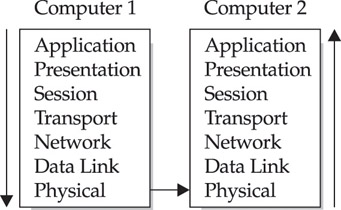Communicating Across the Layers
|
|
Typically, a group of protocols is written to work together within the framework of the architectural model. These protocol groups are called stacks. To communicate across the network, data must travel down the layers in the model on one end and then back up the layers on the other end.
Encapsulation
As data moves down the protocol stack, each layer adds its own information to the mix and encapsulates the data with its header and trailer. Each layer has its own data structure, terminology, and address mechanism. Think of it as wrapping up a box, and then wrapping that box in another box, and so on. On the other end, the boxes are unwrapped in succession; at each layer, the data is processed, and then it's sent up to the next layer in the stack. This process, called decapsulation, continues up the stack until the data is delivered.
Let's follow data as it travels from one machine to another. The top three layers deal with the presentation of information to the transport layer, where real network communication begins, so we'll start there. Figure 8-3 shows the path that the data takes as it travels from one machine to another.

Figure 8-3: The path data takes from one machine to another
At the transport layer on Computer 1, the data is encapsulated into a datagram and sent to the network layer. At the network layer, the datagram is put into a packet, with the datagram as the data portion of that packet. It is then sent to the data link layer, where the packet is put into the data portion of a frame. That frame is sent to the physical layer. At the physical layer, the frame is encoded into bits and sent across the wire to Computer 2.
On Computer 2, the bits are taken off the wire at the physical layer and sent up to the data link layer. At the data link layer, the frame header information is read for the MAC address. If it matches, the process continues, and the data (the layer 3 packet) is sent to the network layer. If it doesn't match, the data is discarded. At the network layer, the IP address is read, and if it is a match, the datagram is sent up to the transport layer. At the transport layer, the port number and protocol are read to determine who gets the data. The data is sent up to the session layer for eventual presentation to the application.
|
|
EAN: 2147483647
Pages: 193